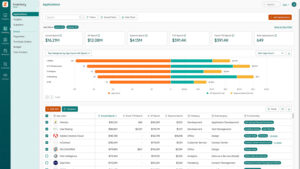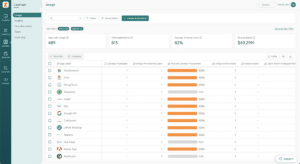Table of Contents
Rising inflation. Mass layoffs. Budget cuts. It’s clear the entire globe has been through a whole lot of economic uncertainty the last couple years.
At times like these, most businesses review their operating expenses with a fine tooth comb, hunting for opportunities to cut unnecessary spending. One of the largest line items is SaaS. In fact, it’s the second largest OpEx behind your people.
Businesses must be able to accurately budget SaaS. But doing so is easier said than done – especially because SaaS is typically purchased throughout the organization.
Cory Wheeler, Chief Customer Officer and Chase Thompson, Director of Product Management teamed up to explore why your current SaaS budget methods may be failing – and what you can do to ensure you’re not leaving money on the table. Read on for the key takeaways from this session.
Despite Economic Uncertainty, SaaS Is Here to Stay – and Growing
Zylo has more SaaS data than any other provider – backed by more than 40M SaaS licenses and $40M+ in SaaS spend under management. When we marry that data with what industry analysts are saying, one thing becomes clear: SaaS spend is growing. In fact, Gartner predicts annual SaaS expenditures will grow 19% year-over-year in 2025.

Right now, there are a lot of businesses in the middle of budgeting season. Based on many conversations with our customers, we know that many are working to flatten or even reduce their overall budget dollars.
But why does SaaS spend continue to grow, despite businesses working to tighten their belts? As Wheeler explained it, “What we know is a lot of SaaS that we see still continuing to grow is really replacing a lot of that headcount that is flat or reduced. As hiring freezes and layoffs are in place, technology is replacing, automating, and making more efficient what would’ve been a headcount or resource in previous years.”
These days, knowledge work takes place in SaaS. “Conferencing solutions, communication, project management – all that is driving efficiency for our customers with their workforce today,” said Wheeler. “SaaS is here to stay and to grow. And SaaS is continuing to power the employee experience.”
SaaS Budgeting Is Hard
SaaS budgeting isn’t easy. In fact, it’s downright hard. “Finding SaaS is difficult. Understanding where it is in your organization is difficult,” said Wheeler. “That extends all the way through budgeting.”
According to Wheeler, the challenges of SaaS budgeting boil down to three factors:
- Disconnect between IT, finance, and lines of business (LOB): Lack of visibility, disjointed systems, and the unpredictable nature of SaaS spend create friction
- Budget vs. actual: This is a manual and time-intensive process, involving repeatedly exporting and combining datasets
- Budget overages: Things like add-on licensing and increased consumption aren’t accounted for in budget planning
But the good news is, there are some concrete ways to drive better SaaS budgeting.
Better Budgeting Starts with Understanding Your SaaS Stack
Understanding what your SaaS stack looks like is the critical first step toward better budgeting. And according to Wheeler, “there’s a lot that goes into it.”
It begins with SaaS inventory management, which discovers and helps you understand every SaaS application you have. But simply knowing how many apps you have isn’t enough. You must also understand:
- Shadow IT
- Sources of spending
- High-spend applications
- Contractual price increases
- Growth/retraction trends
The Future Will Add Complexities to SaaS Budgeting
Effective SaaS budgeting also requires you to consider where your organization is going in the next year or two. For example, consider:
- Headcount: Increasing, decreasing or staying flat
- Budgets: Flat or reduced
- Mergers and acquisitions: Planned M&A introduces another layer of budget complexities
A Single Source of Truth for SaaS Is Key
Many organizations are missing a key piece to better SaaS budgeting. But what is that piece?
As Wheeler puts it, “It is being able to centrally understand all of your SaaS and plan for it accordingly. And that includes a single source of truth for SaaS. And that single source is a centralized solution where finance, IT, your lines of business, everyone is singing off the same song sheet. They understand the expenses, they understand the liabilities and the purchase orders that are extended, and then they are able to now understand what budgets look like.”

This single source of SaaS truth must include:
- Discovery and categorization
- Application information
- Cost and spend details
- Licenses, entitlements, and features
- Term and renewal information
- Ownership information
Your centralized SaaS system of record should also allow you to pull insights together that get you to your desired budgeting outcome through strategies including license rightsizing, rationalization, and benchmarking.
Rightsizing Licenses
“The number one reason that we see that budgets are extended are new license requests,” said Wheeler. “But at the same time, you’ve got to be able to pull back licenses that aren’t being leveraged today. A typical Zylo customer sees up to 40% of inactive licenses usage across their stack.”
With the right insights, you can run a license reclamation workflow to pull back licenses that aren’t being leveraged. “That’s how you can proactively stay under budget, stay under that forecast, and reallocate those licenses.”

App Rationalization
Insights can also fuel informed application rationalization. “A company might say, ‘I see in my SaaS Management solution that we have 12 project management solutions where we know budgets are tight,’” said Wheeler.
The right insights can help that business determine which apps to keep and which to jettison. Wheeler explained, “that step is critical to being able to drive to a budget outcome.”
SaaS Benchmarks
In the world of SaaS, renewals are a golden opportunity to ensure you’re getting the best products at the best price. Having access to the right benchmarking data in your SaaS system of record is key.
“Ahead of your next renewal, you need to determine if you’re getting the right price,” said Wheeler. “You’ve already looked at your licenses. Now you need to look at the price point. Pull in the benchmarking detail and forecast where you might be able to drive that optimization, hold your budget flat, or even potentially bring that down.”

Plan, Manage, and Track Your SaaS Budget
When you have a centralized system of SaaS truth, you can:
- Leverage data-driven insights to inform forecasting
- Implement and execute on cost optimization targets
- Track budget versus actual at the app level
- Ensure spend is in line with department budgets
Zylo Can Help You Ace Your SaaS Budgeting Game
Cory then turned the mic over to Chase Thompson, Director of Product Management at Zylo, to share how Zylo can help businesses ace their SaaS budgeting game.
Chase first shared this quote from Ryan Johnson, VP, IT & Internal Systems at Versapay:
“We believed we had an understanding of what the actual software budget needed to be, based on what we thought we were consuming. Then we brought in Zylo and it ended up we were actually spending 30% more than we thought we were because of a lot of unaccounted spend happening throughout the organization.”
How Versapay Leverages Zylo’s Platform and Managed Services to Take Control of SaaS
Learn how Versapay’s IT team taps into the Zylo platform and a dedicated SaaS management resource to optimize its SaaS portfolio and drive cost and time savings.
This scenario is all-to-common. Organizations often have more apps than they realize. What’s more, the cost of existing apps grows.
“The thing about SaaS is a lot of the billing models lead to growth very tightly aligned to usage,” said Chase. “And usage can take off from just a few core users, and it kind of expands organically. The next thing you know, you’ve got a very big uptick and spend that you did not plan for. And you scale that up to 500 or 1,000 apps – the dollars really add up.”
Chase then shared a few use cases for how Zylo can help fuel better SaaS budgeting.
For starters, Zylo powers better forecasting accuracy by:
- Establishing a SaaS system of record
- Using data-driven insights to rationalize SaaS
- Bolstering and informing forecasting with SaaS payment, usage, benchmark, and contract data
According to Chase, “by default, the entire experience of identifying over or underspend is actually very reactive. And we’ve taken a look at this and said, ‘How can we get just a bit more proactive by managing spend versus actual throughout the year, really set up IT to be a more strategic input to finance and set up for a more proactive budgeting season?’ That’s really our goal here.”
Zylo also helps ensure you’re never caught on your heels. Instead, you can proactively take action based on availability of budget. That might include:
- Proactively increasing purchase orders
- Reallocating licenses versus adding new ones
- Ensuring continuity of service
Finally, Zylo helps you understand unmanaged G&A spend. For example, you can:
- Identify applications without a budget
- Orphaned or redundant applications
- Use-case driven insights to make smart cuts
Take Control of Your SaaS Budgeting
Despite the slowing economy, SaaS is growing. Now, more than ever, it’s imperative to tackle your SaaS spend head-on.
The good news? Zylo’s just released a new App Budgets feature to help you ace your SaaS budgeting. Find out more here.
Interested in exploring these insights further? Watch the full budgeting webinar on demand today.


